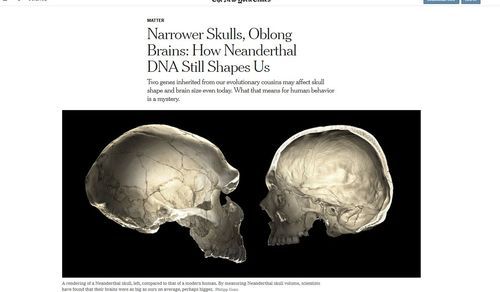


By Steve Sailer
12/13/2018
From the NYT:
Narrower Skulls, Oblong Brains: How Neanderthal DNA Still Shapes Us
Two genes inherited from our evolutionary cousins may affect skull shape and brain size even today. What that means for human behavior is a mystery.
… By measuring Neanderthal skull volume, scientists have found that their brains were as big as ours on average, perhaps bigger.
By Carl Zimmer, Dec. 13, 2018
People who sign up for genetic testing from companies like 23andMe can find out how much of their DNA comes from Neanderthals. For those whose ancestry lies outside Africa, that number usually falls somewhere between 1 percent and 2 percent.
Scientists are still a long way from understanding what inheriting a Neanderthal gene means to people. Some Neanderthal genes may be helpful — improving our defenses against infections, for example — but other bits may leave carriers slightly more prone to certain diseases.
On Thursday, a team of scientists revealed that two pieces of Neanderthal DNA may have another effect: They may change the shape of our brains.
The study, published in the journal Current Biology, wasn’t designed to determine how Neanderthal genes influence thought — if they do so at all. Instead, the value of the research lies in its unprecedented glimpse into the genetic changes influencing the evolution of the human brain. …
Neanderthals and modern humans are evolutionary cousins whose ancestors diverged about 530,000 years ago, possibly somewhere in Africa. Neanderthals left Africa long before modern humans, and their bones were found across Europe, the Near East, and even Siberia.
Before they disappeared about 40,000 years ago, Neanderthals left behind signs of sophistication: spears used to hunt big game, for instance, and jewelry made of shells and eagle talons.
Yet scientists still wonder just how much like us these cousins were. Did they speak a full-blown language? Did they think in symbols?
One thing is clear: They were not short on brains. By measuring the volume inside Neanderthal skulls, researchers have found that their brains were as big as ours, on average, perhaps bigger.
But their brains did not mimic ours. “We have roundish brains,” said Philipp Gunz, a paleoanthropologist at the Max Planck Institute for Evolutionary Anthropology in Leipzig, Germany. “All other human species have elongated brain cases.”
Modern human skulls got rounder because certain regions of the brain changed size. At the back of the brain, for example, a part called the cerebellum dramatically expanded. …
These findings suggest that PHLPP1 and UBR4 evolved to work differently in modern human brains. The modern human version of PHLPP1 may have produced extra myelin in the cerebellum. And our version of UBR4 may have made neurons grow faster in the putamen. …
It’s very hard to predict people’s behavior from their genes, he noted — let alone try to account for a few Neanderthal genes. To learn what they are doing in the brain will require that scientists discern very faint signals amid the noise of the human genome.
“That’s a long way off, if ever possible,” Dr. Capra said.
The natural selection logic could go either way. On the whole, the reason that Eurasians have 98% of their genes inherited from anatomically modern humans is because anatomically modern humans’ genes turned out to have more Darwinian fitness on average than Neanderthals’ genes. On the other hand, the survival of some Neanderthal genes in our DNA over all this time suggests that those Neanderthal genes did something net beneficial, at least in the Eurasian environment.